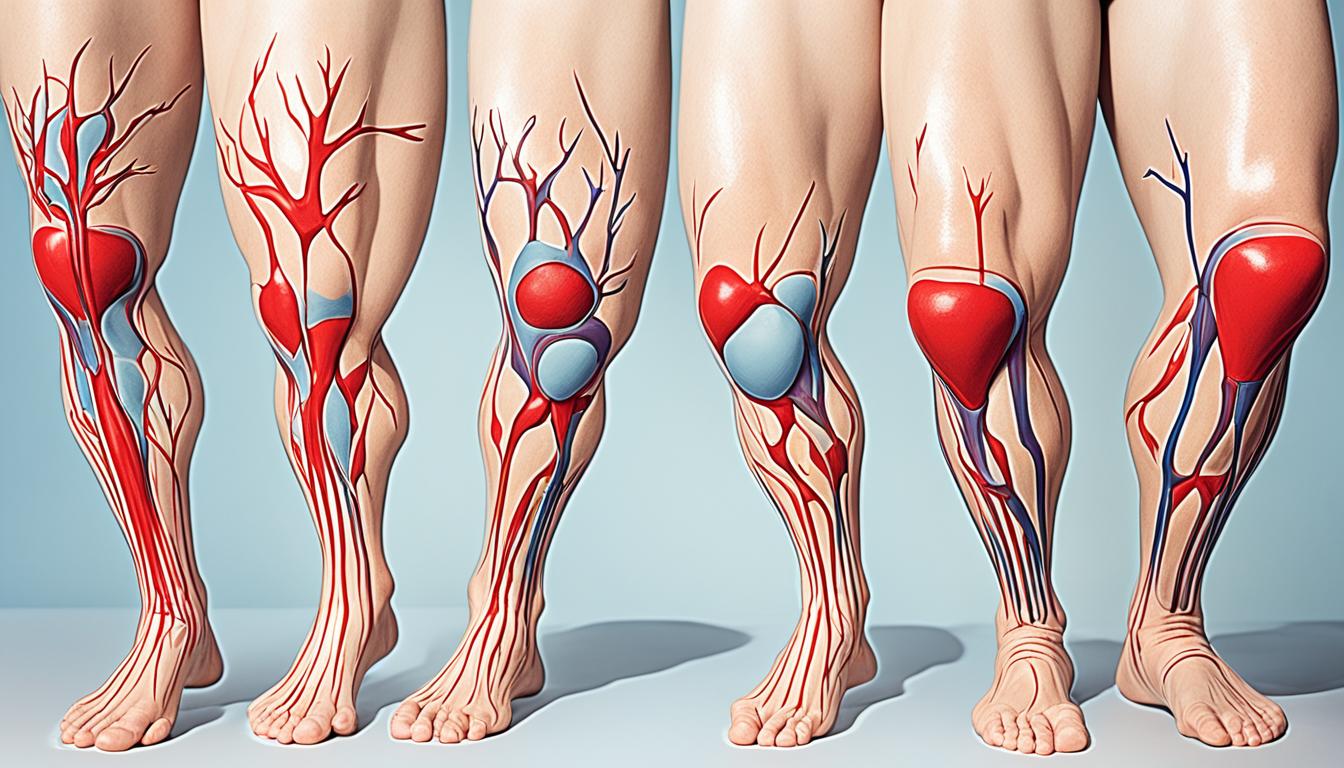Claudication is a vascular disease with leg pain, also called intermittent claudication. It happens due to artery blockage, which slows blood flow to the legs. The key symptom is pain or cramping when moving, like walking, but gets better when you stop. Atherosclerosis, the buildup of plaque in arteries, is a main cause.
Several factors raise the risk of claudication. These include smoking, high blood pressure, high cholesterol, and diabetes. A family history of the disease can also increase your chances. Atherosclerosis makes the blockages worse, causing more circulatory issues.
To diagnose claudication, doctors look at your symptoms, do a physical exam, and use tests like the ankle-brachial index. The ABI test checks blood pressure in your arms and legs to see how much your arteries are blocked. A low ABI value means you likely have claudication.
Treating claudication aims to help with symptoms and improve blood flow, lowering the risk of heart problems. Lifestyle changes are key. This includes quitting smoking, managing blood pressure and cholesterol, and staying at a healthy weight. Exercise can also help by boosting blood circulation in your legs, improving how your arteries work, and reducing leg inflammation.
Key Takeaways:
- Intermittent claudication causes leg pain and cramping when you move.
- Plaque buildup in the arteries, known as atherosclerosis, is its main cause.
- Things like smoking, high blood pressure, and diabetes can raise your risk.
- Doctors diagnose it by looking at symptoms and using tests like the ABI.
- Treatments include lifestyle changes, exercise, and medications to manage symptoms and cut heart risks.
- Stem cell therapy is a new approach that focuses on growing new blood vessels to increase blood flow.
Risk Factors and Diagnosis of Claudication
Claudication is a condition that causes leg pain and cramping during activity. It’s linked to several risk factors. Knowing these can help us spot and treat it better.
Risk Factors
Smoking stands out as the biggest risk factor you can change. It leads to plaque buildup in your arteries, hurting blood flow. This, in turn, causes leg pain. High blood pressure, high cholesterol, diabetes, and family history of claudication are other key risks.
Claudication is often caused by atherosclerosis. This condition makes arteries narrow by building up plaque. As a result, blood flow to the legs decreases, causing pain and cramps during exercise.
Diagnosis
To find if someone has claudication, doctors look at their symptoms and do a full exam. They might also do tests like the ankle-brachial index (ABI). This helps see how bad the artery blockage is and if claudication is present.
The ABI is a special test that checks blood pressure in the arms and legs. It tells us about blockages and blood flow problems. A score under 0.9 means there’s a significant artery blockage, hinting at claudication.
Knowing and checking for claudication’s risks, plus using tools like the ABI, helps doctors find and treat the condition early.
Treatment Options for Claudication and the Potential of Stem Cell Therapy
Treatments for claudication work to better symptoms, boost blood flow, and cut down on heart risks. Changing your lifestyle is a key part of treatment. It involves not smoking, watching your blood pressure, handling high cholesterol, and staying a healthy weight. Doing exercises, especially with a mentor, improves symptoms by making more blood vessels, bettering how your blood vessels work, and lowering swelling.
Doctors might also give you medicines like antiplatelet drugs, statins, and ACE inhibitors. These help control symptoms and lessen heart risks. They make blood flow better and slow down the hardening of your arteries. It’s also crucial to manage factors that make your risks higher. This means dealing with diabetes and keeping your blood pressure in check.
Stem cell therapy is a new area in treating claudication. It means putting your own bone marrow stem cells into your body to grow new blood vessels. This improves blood flow where it’s needed. Early signs show this can help with symptoms and save limbs. While still being researched, this therapy shines a new light for claudication patients. It could make blood circulation better and life quality improve.
FAQ
Q: What is claudication?
A: Claudication is a kind of vascular disease that causes leg pain. This pain is often called intermittent claudication. It happens when the arteries in the legs are blocked or narrow, reducing blood flow.
Q: What are the main symptoms of claudication?
A: The key sign of claudication is leg pain or cramps during activities like walking. The pain gets better with rest.
Q: What causes claudication?
A: Claudication is mainly caused by atherosclerosis. It’s where plaque builds up in the arteries, making less blood flow through.
Q: What are the risk factors for developing claudication?
A: Smoking, high blood pressure, high cholesterol, diabetes, and family history increase claudication risk.
Q: How is claudication diagnosed?
A: Doctors diagnose claudication using symptoms, physical exams, and tests like the ankle-brachial index.
Q: What treatment options are available for claudication?
A: To treat claudication, lifestyle changes are crucial, like quitting smoking and exercising. Doctors may also prescribe meds to help with symptoms and reduce heart risks.
Q: What is stem cell therapy and how is it used to treat claudication?
A: Stem cell therapy is a new approach for claudication. It uses the patient’s own bone marrow stem cells. These cells help grow new blood vessels and enhance blood flow in the legs. This method aims to reduce claudication symptoms.

